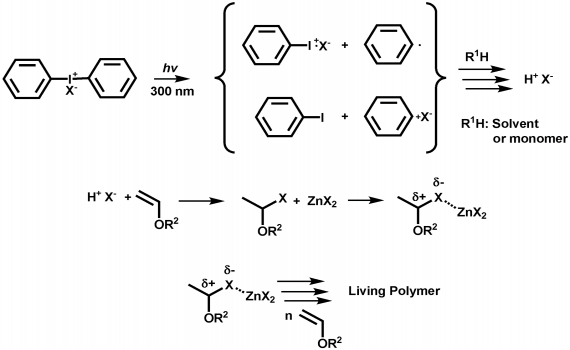Unprecedented controlled radical vinyl polymerization crp of vinyl ethers using reversible addition fragmentation chain transfer raft polymerization is reported.
Vinyl ether polymerization radical.
Provided is a method for the polymerization of vinyl ethers catalyzed by complexes of a lithium salt and a polyether.
Radical cationic acrylate vinyl ether radical figure 5.
In order to overcome the challenge of direct radical polymerization of vinyl ethers commercial hydroxy functional vinyl ethers such as 2 hydroxyethyl vinyl ether heve were subjected to free radical polymerization generating.
Thienyl chloride initiated living cationic polymerization.
Polymerization rate in figure 5 the conversion of acrylate 1407 cm 1 and vinyl ether groups 1618 cm 1 are plotted as a function of vinyl ether content.
The photoinitiated cationic polymerization of vinyl ether ve monomers has been studied by real time infrared spectroscopy.
This method however is highly sensitive to monomer structure and achieved only 76 m and 64 m in the case of n butyl bve and ethyl vinyl ether eve respectively.
The resulting polymers are produced under mild and controlled conditions and are useful in adhesives and coatings as well as in other uses such as for polymer electrolytes in batteries and for viscosity.
A general and efficient access toward terminally functionalized poly vinyl ether s.
For example the state of the art method uses a phenoxide ligated titanium complex to achieve 92 meso diads m in the polymerization of iso butyl vinyl ether ibve.
It is remarkable that only 10 addition of dve 3 increases the conversion of the acrylate from.
A new photoinitiating system for living cationic polymerization of vinyl ethers is reported.
Vinyl ethers 1 which have a strongly electron donating alkoxy substituent readily form polymers on treatment with an acidic compound initiator the polymerization is thus cationic in nature.
Macromolecules 2020 53 5 1536 1542.
A novel uv curing vinyl ether lcs with a wide temperature range was developed by mixturing various vinyl ether lc monomers.
No anionic or radical polymerizations give high polymers from vinyl ethers except for the alternating radical copolymerization with an electron deficient monomer.
In the current approach visible light irradiation of dimanganese decacarbonyl mn 2 co 10 in the presence of an alkyl bromide results in the formation of carbon centered radicals the photochemically generated radicals were then oxidized by diphenyliodonium ions to the corresponding cations.










